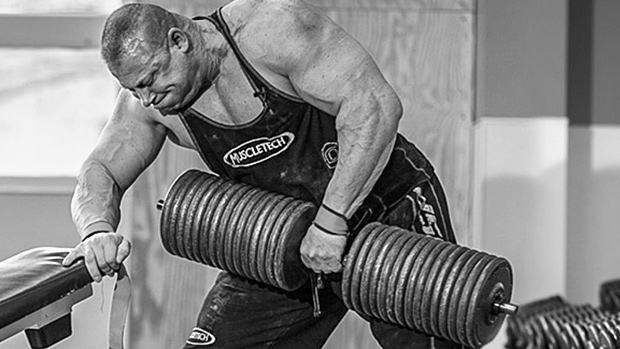Kroc rows are the kipping pull-ups of rowing exercises. If you saw a normal-sized person doing Kroc rows, you'd think they're using too heavy of a weight and using poor form to cheat the heck out of the lift.
Would you think the same thing if it was some monster strongman doing them? No, probably not. You'd just say he was doing Kroc rows.
Look, we need to remain logically consistent on training principles. We need to understand the context of what we're doing because training principles aren't determined by how big one's back is or what his lifting totals are.
I've read that Kroc used them for heavy, high reps (sets of 20) specifically because he felt it helped improve his deadlift performance. So using Kroc rows for that purpose makes good sense, just like using kipping pull-ups makes sense for some (CrossFit competitors).
However, most people aren't powerlifters and they need to think about the context of exercises such as Kroc rows. If you're someone who's trying to do one-arm rows to develop strength in the involved muscles, then using your legs and hips to launch (instead of lift) that weight up isn't the way to do it.
Do 747 Dumbbell Rows Instead
If you're looking for a form-focused, high-volume alternative to Kroc rows, look no further than the 747 hybrid row:
Do these row variations back-to-back without rest until you've completed all three exercises with both arms:
- A1. One-Arm Free Standing Dumbbell Row, 7 reps each arm
- A2. One-Arm Supported Dumbbell Row, 4 reps each arm using a heavier load that A1
- A3. One-Arm Dumbbell Off-Bench Row, 7 reps using a slightly lighter load than used on A1
- Do 2-3 sets with 4-6 minutes between sets.
Coaching Tips
One-Arm Free Standing Dumbbell Row
Use a weight you can do for 8-9 reps with good form. Keeping your shoulders parallel to the ground, rotate it slightly toward the same side you're holding the dumbbell on. This forces you to use of your mid-back through the full range of motion involved at the top of the exercise.
One-Arm Dumbbell Row
The additional base of support allows you to pull heavier loads. Push your support arm into the bench as you row the dumbbell with your other arm. Explode into the weight on each rep. The weight won't go up fast (despite your intent to lift it fast) because you'll be using the heaviest weight you can manage for four reps.
One-Arm Dumbbell Off-Bench Row
Perform with your torso parallel to the floor using a weight you can do for more than 8 reps with good form. This move offers more base of support than free-standing rows, but less than the traditional dumbbell rows with your knee on the bench. That makes it a nice middle ground between the first two exercises.
Additional Notes
The less base of support you have when doing a dumbbell row, the more you've got to use your hips and torso to stay in place. So mixing up the row variations slightly changes the muscular demand and also keeps this protocol more interesting than a traditional high-rep set.
You can do this same rep scheme using the same dumbbell row variation if you'd like.
The 747 rep scheme isn't some magic rep number, so you can tweak it a bit. In fact, sometimes you may only get 6 reps on the final exercise due to fatigue. Or maybe you get 9 reps on the final exercise because you're feeling like an animal.





